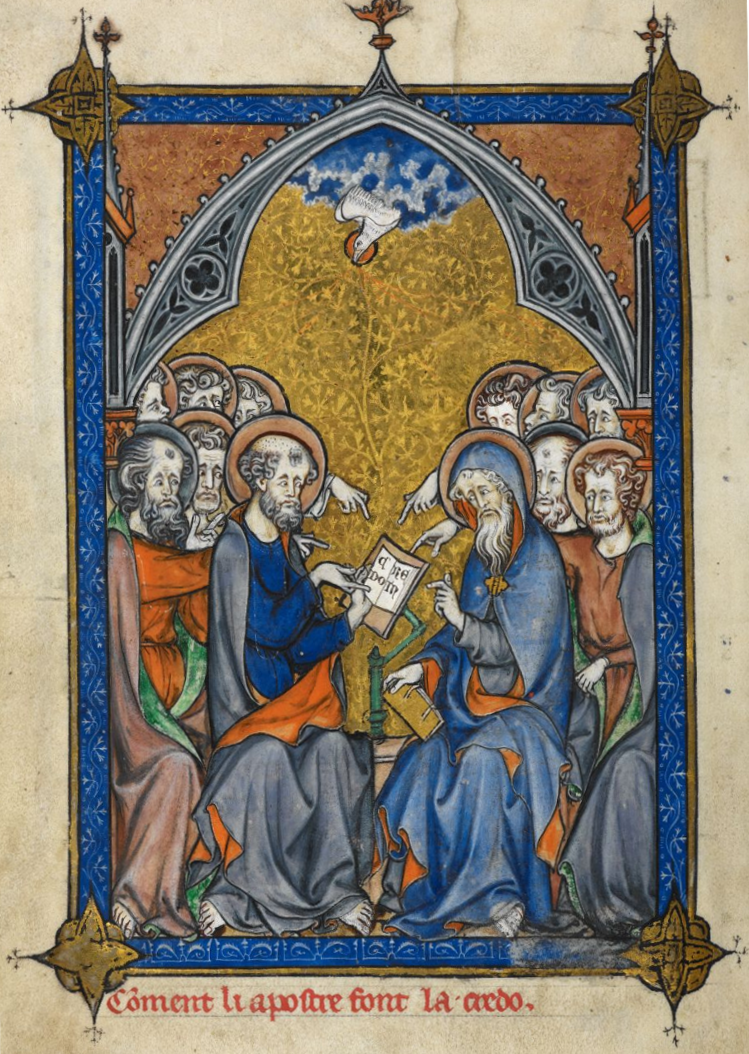

I always judge books by their covers. In part, this habit is a terrible prejudice, but I also think it’s a useful way of deciding how to use limited time on an unlimited supply of books. Thankfully, Lexham Press crafted a beautiful design for their recent book The Apostles’ Creed: A Guide to the Ancient Catechism. It’s the first in their “Christian Essentials” series, set to cover the Ten Commandments, baptism, the Lord’s Supper, the Lord’s Prayer, and corporate worship.
In this book, form and content match beautifully. The design, which merges traditional iconography and contemporary minimalism, reflects the text itself, with its fresh approach to classic Christian documents (i.e. the Creed itself, but read alongside Augustine, Irenaeus, Origen, and other theologians through the ages). And with Ben Myers’ careful but unobtrusive bibliography, intellectually interested readers can track down every citation, while others not keen on obscure theology can enjoy without distraction. Ancient and current, academic and accessible, the book bridges a lot of divides that few do (or can).
I first discovered the book’s classic and contemporary interests toward the very beginning, when Myers’ considers claims about “God the Father.” As he writes,
Today many Christians are uneasy about this word. Doesn’t it give a privileged place to masculine language? Doesn’t it imply that there is gender in God? Doesn’t it reinforce the picture of an old bearded man in the sky? These might sound like contemporary concerns. But early Christian teachers were already sensitive to these problems. …
In a sermon preached in Constantinople toward the end of the fourth century, Gregory of Nazianzus explained that the words “Father” and “Son” should be used without having any “bodily ideas” in our minds. Otherwise we would be back in paganism, imagining a God who physically procreated in order to bring forth a son. We use the words “Father” and “Son,” Gregory says, “in a more elevated sense.” We “accept the realities without being put off by the names.” Ordinary family connotations cannot be applied to God, much less connotations of gender. “Do you take it,” Gregory asks his congregation, “that our God is a male because of the masculine nouns ‘God’ and ‘Father’? Is the ‘Godhead’ a female because in Greek the word is feminine?” Such crude biological thinking would be pagan, not Christian.
What then does the word “Father” mean? For Christians, the word describes a relationship and nothing more. Here is Gregory again: “‘Father’ designates neither the substance nor the activity, but the relationship, the manner of being, which holds good between the Father and the Son.” The Father is the source, the origin, the wellspring of divine life, and the Son derives from that source.
From here, Myers quickly goes on to finesse the troublesome territory of early trinitarian debates. He continues:
If the word “Father” refers to a relation of origin within God, then we can draw one important conclusion: God is not only Father but also Son. These words, “Father” and “Son,” are relational terms. Neither would makes sense without the other. Writing in the second century, Tertullian was the first to develop this simple but important insight: “Father makes son, and son makes father. … A father must have a son to be a father, and a son must have a father to be a son.” When we confess that God is eternally Father, we always have in mind as well the eternal reality of the Son.
The section sets the agenda for much of the book: full of scripture and tradition, but eager to respond to contemporary anxieties about the relevance of the two.
Along the way, Myers’ digests the Creed into tiny units. This breakdown, nuanced but concise, begins with the single word “I” at the Creed’s beginning, before it concludes by investigating “Amen.” Some readers may find this pace tedious at first. But reading it, I enjoyed the unhurried contemplation it invited for words so often recited but not always explored. After all, who is the “I” claiming to “believe” all this? Myers asks exactly this question and finds a much more profound answer than one may expect of a single word. Throughout the book, as he gives similar attention to every part of the Creed, he demonstrates their historical and living significance for the community of Christ.
In an Mbird conference talk a few years ago, Francis Spufford asked, “Can You Say the Creed (and Still Call Your Soul Your Own)?” *Spoiler alert* Yes and no. In the Gospel, Spufford says, God makes us both more ourselves and less the autonomous selves we told ourselves we were. Which is where Myers winds up, too: “It is really Christ who prays and sings and declares the amen.” When “I” recite the Creed and declare the “Amen,” it is not the individual “me” but Christ himself, in his body the church. The good news in the Creed isn’t just a hope, but a completed reality in Christ, who is himself the Amen.

COMMENTS
Leave a Reply













